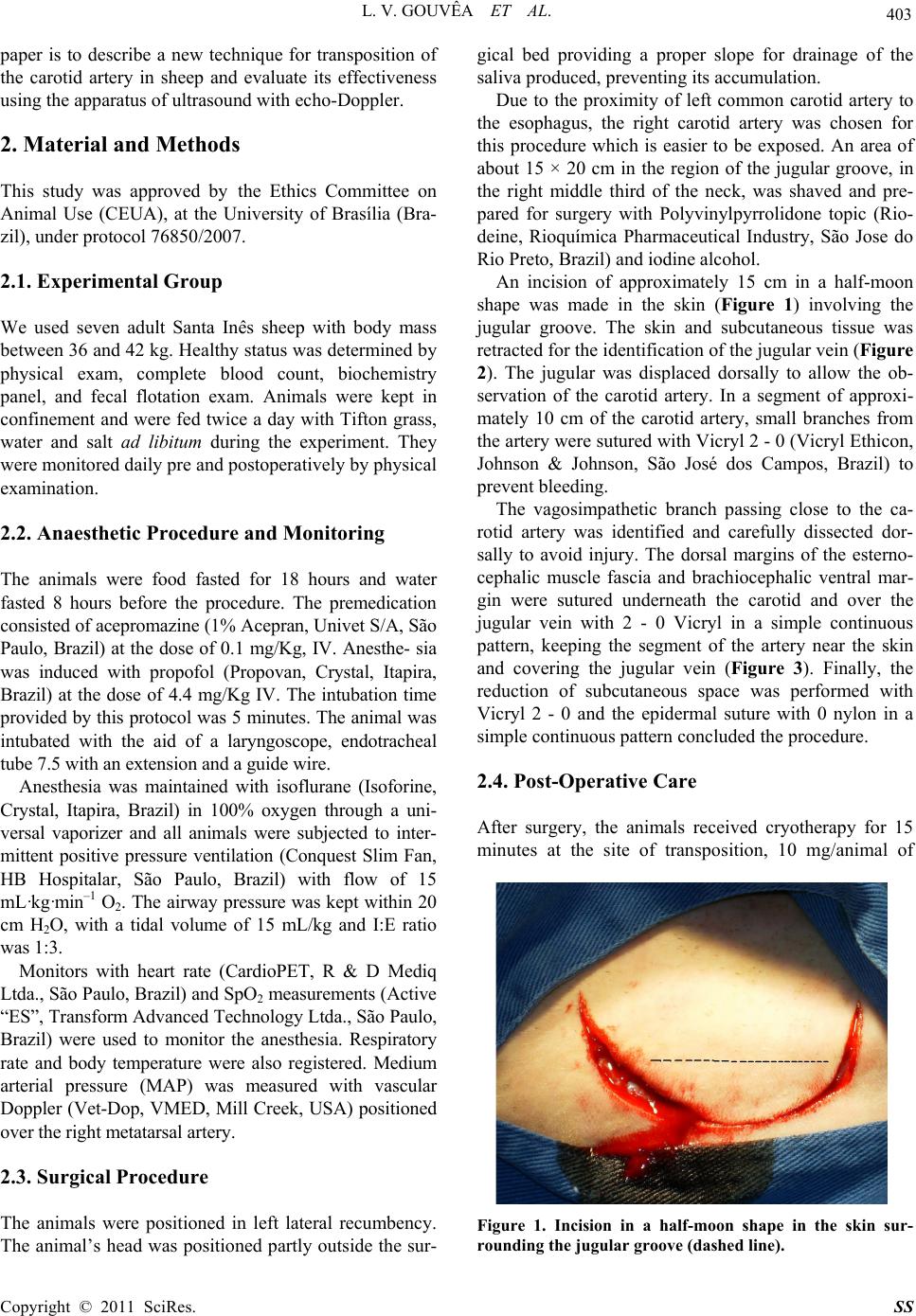
L. V. GOUVÊA ET AL.
403
paper is to describe a new technique for transposition of
the carotid artery in sheep and evaluate its effectiveness
using the apparatus of ultrasound with echo-Doppler.
2. Material and Methods
This study was approved by the Ethics Committee on
Animal Use (CEUA), at the University of Brasília (Bra-
zil), under protocol 76850/2007.
2.1. Experimental Group
We used seven adult Santa Inês sheep with body mass
between 36 and 42 kg. Healthy status was determined by
physical exam, complete blood count, biochemistry
panel, and fecal flotation exam. Animals were kept in
confinement and were fed twice a day with Tifton grass,
water and salt ad libitum during the experiment. They
were monitored daily pre and postoperatively by physical
examination.
2.2. Anaesthetic Procedure and Monitoring
The animals were food fasted for 18 hours and water
fasted 8 hours before the procedure. The premedication
consisted of acepromazine (1% Acepran, Univet S/A, São
Paulo, Brazil) at the dose of 0.1 mg/Kg, IV. Anesthe- sia
was induced with propofol (Propovan, Crystal, Itapira,
Brazil) at the dose of 4.4 mg/Kg IV. The intubation time
provided by this protocol was 5 minutes. The animal was
intubated with the aid of a laryngoscope, endotracheal
tube 7.5 with an ext ensi on an d a g ui de wire.
Anesthesia was maintained with isoflurane (Isoforine,
Crystal, Itapira, Brazil) in 100% oxygen through a uni-
versal vaporizer and all animals were subjected to inter-
mittent positive pressure ventilation (Conquest Slim Fan,
HB Hospitalar, São Paulo, Brazil) with flow of 15
mL·kg·min–1 O2. The airway pressure was kept within 20
cm H2O, with a tidal volume of 15 mL/kg and I:E ratio
was 1:3.
Monitors with heart rate (CardioPET, R & D Mediq
Ltda., São Paulo, Brazil) and SpO2 measurements (Active
“ES”, Transform Advanced Technology Ltda., São Paulo,
Brazil) were used to monitor the anesthesia. Respiratory
rate and body temperature were also registered. Medium
arterial pressure (MAP) was measured with vascular
Doppler (Vet-Dop, VMED, Mill Creek, USA) positioned
over the right metatarsal artery.
2.3. Surgical Procedure
The animals were positioned in left lateral recumbency.
The animal’s head was positioned partly outside the sur-
gical bed providing a proper slope for drainage of the
saliva produced, preventing its accumulation.
Due to the proximity of left common carotid artery to
the esophagus, the right carotid artery was chosen for
this procedure which is easier to be exposed. An area of
about 15 × 20 cm in the region of the jugular groove, in
the right middle third of the neck, was shaved and pre-
pared for surgery with Polyvinylpyrrolidone topic (Rio-
deine, Rioquímica Pharmaceutical Industry, São Jose do
Rio Preto, Brazil) and iodine alcohol.
An incision of approximately 15 cm in a half-moon
shape was made in the skin (Figure 1) involving the
jugular groove. The skin and subcutaneous tissue was
retracted for the identification of th e jugular vein (Figure
2). The jugular was displaced dorsally to allow the ob-
servation of the carotid artery. In a segment of approxi-
mately 10 cm of the carotid artery, small branches from
the artery were sutured with Vicryl 2 - 0 (Vicryl Ethicon,
Johnson & Johnson, São José dos Campos, Brazil) to
prevent bleeding.
The vagosimpathetic branch passing close to the ca-
rotid artery was identified and carefully dissected dor-
sally to avoid injury. The dorsal margins of the esterno-
cephalic muscle fascia and brachiocephalic ventral mar-
gin were sutured underneath the carotid and over the
jugular vein with 2 - 0 Vicryl in a simple continuous
pattern, keeping the segment of the artery near the skin
and covering the jugular vein (Figure 3). Finally, the
reduction of subcutaneous space was performed with
Vicryl 2 - 0 and the epidermal suture with 0 nylon in a
simple continuous pattern concluded the procedure.
2.4. Post-Operative Care
After surgery, the animals received cryotherapy for 15
minutes at the site of transposition, 10 mg/animal of
Figure 1. Incision in a half-moon shape in the skin sur-
rounding the jugular groove (dashed line).
Copyright © 2011 SciRes. SS